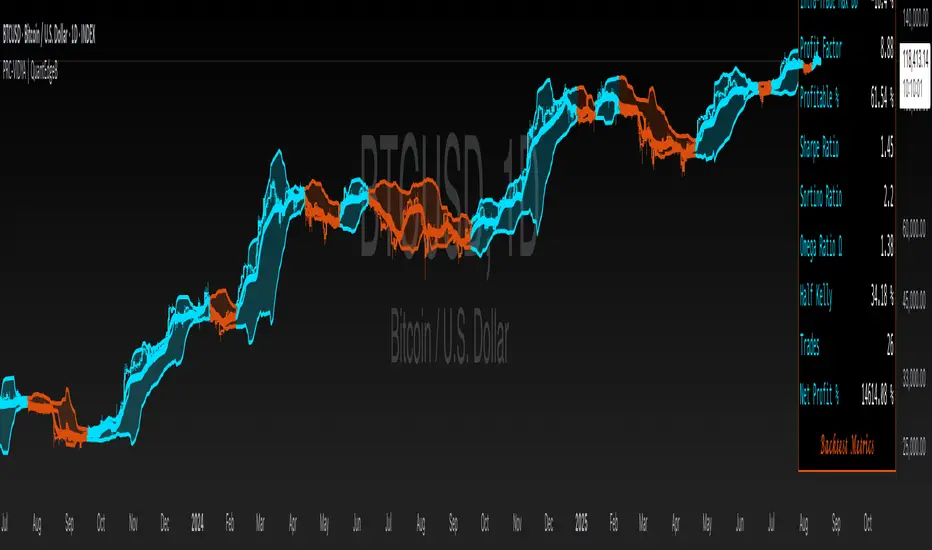PRC-VIDYA | QuantEdgeB

Overview
The PRC-VIDYA(Volatility–Indexed Dynamic Average) is a sophisticated trading indicator developed for traders looking to capitalize on trend shifts with enhanced filtering mechanisms. It blends an Endpoint VIDYA filter—an adaptive, volatility-scaled moving average with percentile-based thresholds and a median-absolute-deviation buffer to craft a dynamic entry/exit envelope. Price thrusts beyond the upper or lower band generate crisp long/short signals, complete with colored fills, candle tinting, alerts and optional backtest stats
____
Key Features
🔹VIDYA(Volatility–Indexed Dynamic Average):
- Adaptive Moving Average that adjusts its responsiveness based on market volatility.
- Uses a dynamic smoothing constant based on standard deviations.
- Allows for better trend detection compared to static moving averages.
🔹2. Percentile Rank-Based Dynamic Levels:
- Identifies overbought (75th percentile) and oversold (25th percentile) zones.
- Dynamically adjusts based on historical data, making it robust across different market conditions.
🔹3. Median Absolute Deviation (MAD) Filtering:
- An advanced volatility filter that refines entry and exit points.
- Reduces noise by filtering out weak signals, focusing only on meaningful trend shifts.
- Uses two multipliers (long and short) to fine-tune sensitivity.
🔹4. Signal Generation:
- 📈Long Signal: Triggered when price closes above the upper dynamic threshold.
- 📉Short Signal: Triggered when price closes below the lower dynamic threshold.
- Uses color-coded candles to visually indicate trend shifts.
- Optional signal labels can be enabled for clear entry/exit indications.
🔹5. Customizable Visualization:
- Multiple color themes to match user preferences.
- Ability to overlay signals on price charts.
- Alerts available for long & short crossovers.
_____
How It Works
1. The script calculates VIDYA based on a user-defined period.
2. It computes the 75th and 25th percentile ranks of the moving average.
3. Median Absolute Deviation (MAD) Filtering is applied to reduce false breakouts.
4. A buy (long) or sell (short) signal is triggered when price crosses the respective filtered percentile levels.
5. Alerts and labels can be used to notify traders of new signals.
_____
Behavior across Crypto Majors
BTC
ETH
SOL
Note: Past behaviour is not indicative of future results. Always conduct thorough testing and risk management before making trading decisions.
_____
Best Use Cases
📌 Trend Confirmation – Use VIDYA to confirm if a trend is strengthening or weakening.
📌 Noise Reduction – MAD filtering prevents reacting to minor fluctuations, focusing on stronger trend shifts.
📌 Multi-Timeframe Scalability – Works across multiple timeframes (1H, 4H, Daily, etc.), depending on the trader’s strategy.
🧬 Default Settings
• Endpoint VIDYA Mode: “Mid” (9 bar, 24 bar hist)
• Percentile Length: 21 bars
• Upper/Lower Percentiles: 75% / 25%
• MAD Window: 21 bars
• Upper/Lower MAD Multipliers: 1.8 / 0.9
• Visuals: Candle coloring on, labels off, “Strategy” palette
• Backtest Table: off by default
_____
📌 Conclusion
PRC-VIDYA fuses a volatility-aware adaptive average with percentile boundaries and a robust deviation buffer, yielding a self-adjusting channel that captures genuine breakouts and breakdowns. Its clear regime coloring, alerts and optional backtest table make it a turnkey solution for traders who want signals that breathe with the market.
🔹 Disclaimer: Past performance is not indicative of future results. No trading strategy can guarantee success in financial markets.
🔹 Strategic Advice: Always backtest, optimize, and align parameters with your trading objectives and risk tolerance before live trading.
Skrip jemputan sahaja
Hanya pengguna yang diluluskan oleh penulis boleh mengakses skrip ini. Anda perlu memohon dan mendapatkan kebenaran untuk menggunakannya. Ini selalunya diberikan selepas pembayaran. Untuk lebih butiran, ikuti arahan penulis di bawah atau hubungi terus QuantEdgeB.
TradingView tidak menyarankan pembayaran untuk atau menggunakan skrip kecuali anda benar-benar mempercayai penulisnya dan memahami bagaimana ia berfungsi. Anda juga boleh mendapatkan alternatif sumber terbuka lain yang percuma dalam skrip komuniti kami.
Arahan penulis
whop.com/quantedgeb/ 💎
🔹 Unlock our free toolbox:
tradinglibrary.carrd.co/ 🛠️
Disclaimer: All resources and indicators provided are for educational purposes only
Penafian
Skrip jemputan sahaja
Hanya pengguna yang diluluskan oleh penulis boleh mengakses skrip ini. Anda perlu memohon dan mendapatkan kebenaran untuk menggunakannya. Ini selalunya diberikan selepas pembayaran. Untuk lebih butiran, ikuti arahan penulis di bawah atau hubungi terus QuantEdgeB.
TradingView tidak menyarankan pembayaran untuk atau menggunakan skrip kecuali anda benar-benar mempercayai penulisnya dan memahami bagaimana ia berfungsi. Anda juga boleh mendapatkan alternatif sumber terbuka lain yang percuma dalam skrip komuniti kami.
Arahan penulis
whop.com/quantedgeb/ 💎
🔹 Unlock our free toolbox:
tradinglibrary.carrd.co/ 🛠️
Disclaimer: All resources and indicators provided are for educational purposes only